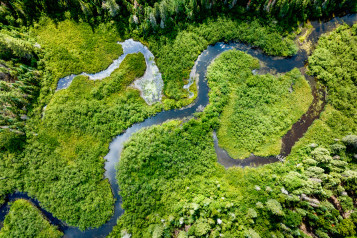Publication
The Government of Canada enacts Offset Regulations: here's what you need to know
Published June 16, 2022
On June 8, 2022, the Government of Canada enacted the Canadian Greenhouse Gas Offset Credit System Regulations (Offset Regulations). The Offset Regulations have been enacted under sections 192 and 195 of the Greenhouse Gas Pollution Pricing Act and section 5 of the Environmental Violations Administrative Monetary Penalties Act, and will enable projects governed by the federal Output-Based Pricing System (OBPS) to generate and sell carbon credits. These carbon credits can be used by facilities covered by the federal OBPS to meet their greenhouse gas (GHG) emissions compliance obligations. Requirements for projects registered under the Offset Regulations are further set out in applicable federal offset protocols (Offset Protocols), which describe the approach for quantifying GHG reductions or removals for a given type of project.
Background
Canada, along with other members of the international community, committed to the Paris Agreement in December 2015. The agreement seeks to limit the rise in global temperatures to less than 2 degrees Celsius, with the aim of preventing temperature increases beyond 1.5 degrees Celsius above pre-industrial levels. The federal government has stated that the adoption of the Offset Regulations is an important part of Canada's climate action plan, and that, "the potential to generate federal offset credits will incentivize activities leading to reductions in GHG emissions by either preventing GHGs from being emitted or by removing GHGs from the atmosphere."
Eligibility to generate credits under the Offset Regulations
In order for a project to generate federal offset credits under the Offset Regulations, project proponents must meet a number of requirements. These requirements include:
- registration of the project in accordance with specified conditions;
- maintaining a GHG Offset Credit System Account in the credit tracking system;
- implementation of a project that generates GHG reductions that are real, additional, quantified, verified, unique and permanent;
- preparation of project reports and verification of project reports by an accredited verification body; and
- if applicable, the implementation of a reversal risk management plan to mitigate the risk of GHG reversal.
Specified conditions identified above that must be met in order to register a project under the Offset Regulations require that:
- the project proponent has the exclusive entitlement to the credits produced;
- the project is not registered under any other offset credit system; and
- the proponent has the necessary authorizations to carry out the project activities.
The requirements are further set out in applicable federal Offset Protocols. These protocols set out the approach for quantifying GHG reductions or removals for a given type of project.
Project proponents can also only register projects that produce carbon credits in accordance with applicable Offset Protocols, which are incorporated into the Offset Regulations. The Offset Protocols provide different rules for the production of carbon credits by different types of projects, with the goal of setting out, "a consistent approach of quantifying GHG reductions for a given project type." Currently, the Offset Protocols only establish a protocol for the production of credits under the Landfill Methane Recovery and Destruction protocol. This means that for the time being, only projects aimed at reducing GHG emissions from landfills are eligible to generate federal emissions credits. However, the federal government plans to implement protocols relating to:
- reduction of GHG emissions from refrigeration systems;
- improved forest management;
- enhanced soil organic carbon; and
- livestock feed management.
Work is also underway for the development of protocols relating to direct air carbon capture and sequestration, along with plans for protocols relating to:
- improved forest management on public lands;
- bioenergy carbon capture and sequestration;
- livestock manure management; and
- anaerobic digestion.
Credit generation and use
When a project has been registered according to the above requirements, credits are generated as reductions or removals of carbon are made beyond business-as-usual practices and legal requirements. For every tonne of carbon dioxide equivalent reduced, a project is awarded one offset credit. Credits can then be used by companies regulated under the federal OBPS to meet their compliance obligations and reduce their cost of compliance. The federal OBPS applies to facilities carrying out industrial activities in provinces and territories without their own OBPS that emit 50 kilotonnes or more of carbon dioxide equivalent each year.
Compliance obligations under the federal OBPS can be met in a number of ways, including by paying the applicable price per tonne on carbon emitted, or by using compliance units, which include:
- surplus credits generated under the federal OBPS purchased by an emitter;
- surplus credits issued by the Minister; and
- eligible provincial or territorial offset credits formally recognized under the Output-Based Pricing System Regulations as compliance units.
Additionally, the Offset Regulations allow for voluntary participants to enter the federal compliance market. Businesses who have voluntarily made commitments to reduce emissions and governments seeking to reduce their environmental impact will also be able to purchase carbon credits produced under the new Offset Regulations.
Interaction with the provincial regimes
The Offset Regulations apply across Canada. Project proponents may register a project under the Offset Regulations even if the project is developed in a province that has designed its own carbon pricing system (subject to the federal backstop). Currently, the provinces of Alberta, B.C. and Quebec, have all designed their own offset programs, and the flexibility to register under the federal OBPS is available to project proponents in those provinces.
However, under the Offset Regulations, if a province has already created a protocol for the production of carbon offsets relating to a certain reduction activity, that project cannot produce credits under the federal Offset Regulations (subject to some limited exceptions). This means that project proponents in those provinces must determine whether a provincial protocol in those provinces currently exists for the production of carbon offsets from a certain type of activity.
Because the Offset Protocol categories are limited in number, the Offset Regulations will likely not have a significant impact in Alberta for the time being. Alberta currently has eighteen approved protocols in place, including the Landfill Gas Capture and Combustion protocol. Until unique protocols are introduced by the federal government, the wide range of protocols available in Alberta will limit the ability for project proponents to generate federal credits.


